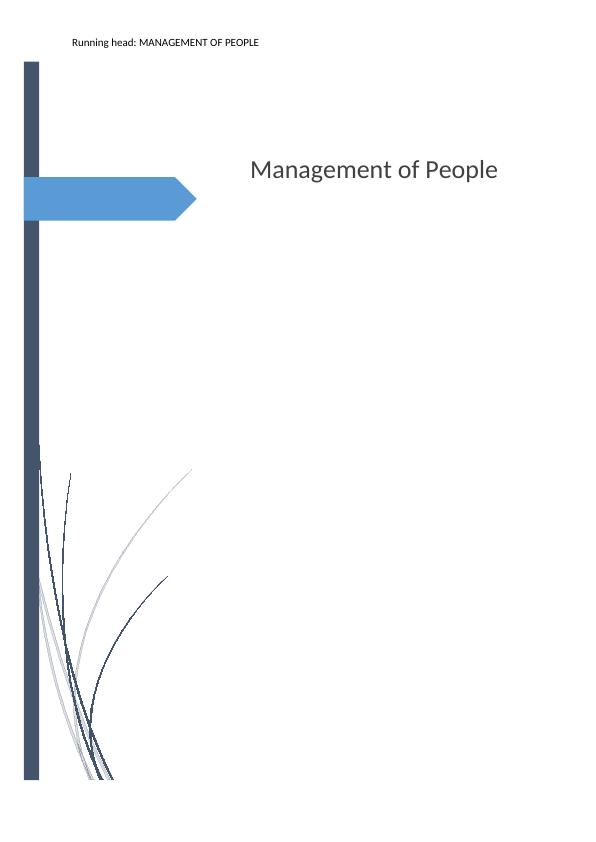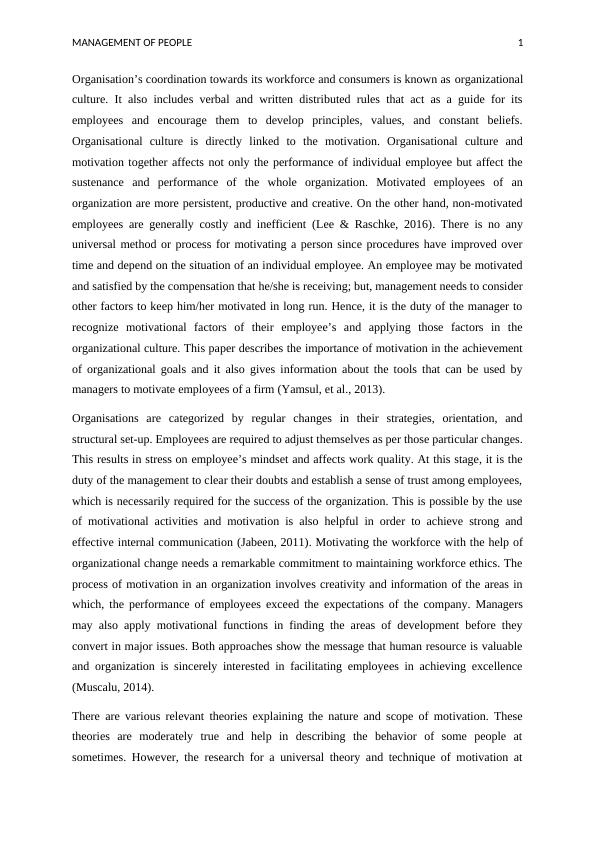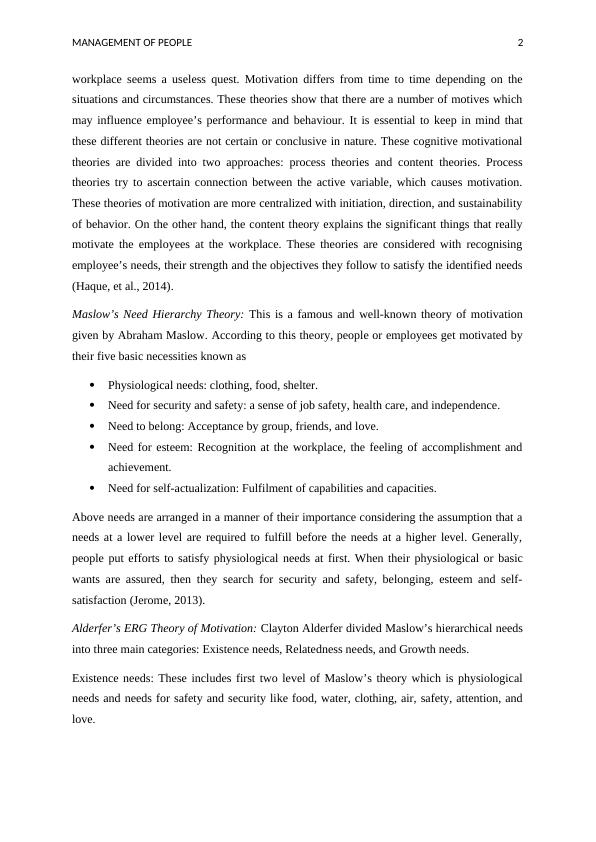Importance of Motivation in Achieving Organizational Goals
Added on 2023-06-12
9 Pages3005 Words65 Views
Running head: MANAGEMENT OF PEOPLE
Management of People
Management of People

MANAGEMENT OF PEOPLE 1
Organisation’s coordination towards its workforce and consumers is known as organizational
culture. It also includes verbal and written distributed rules that act as a guide for its
employees and encourage them to develop principles, values, and constant beliefs.
Organisational culture is directly linked to the motivation. Organisational culture and
motivation together affects not only the performance of individual employee but affect the
sustenance and performance of the whole organization. Motivated employees of an
organization are more persistent, productive and creative. On the other hand, non-motivated
employees are generally costly and inefficient (Lee & Raschke, 2016). There is no any
universal method or process for motivating a person since procedures have improved over
time and depend on the situation of an individual employee. An employee may be motivated
and satisfied by the compensation that he/she is receiving; but, management needs to consider
other factors to keep him/her motivated in long run. Hence, it is the duty of the manager to
recognize motivational factors of their employee’s and applying those factors in the
organizational culture. This paper describes the importance of motivation in the achievement
of organizational goals and it also gives information about the tools that can be used by
managers to motivate employees of a firm (Yamsul, et al., 2013).
Organisations are categorized by regular changes in their strategies, orientation, and
structural set-up. Employees are required to adjust themselves as per those particular changes.
This results in stress on employee’s mindset and affects work quality. At this stage, it is the
duty of the management to clear their doubts and establish a sense of trust among employees,
which is necessarily required for the success of the organization. This is possible by the use
of motivational activities and motivation is also helpful in order to achieve strong and
effective internal communication (Jabeen, 2011). Motivating the workforce with the help of
organizational change needs a remarkable commitment to maintaining workforce ethics. The
process of motivation in an organization involves creativity and information of the areas in
which, the performance of employees exceed the expectations of the company. Managers
may also apply motivational functions in finding the areas of development before they
convert in major issues. Both approaches show the message that human resource is valuable
and organization is sincerely interested in facilitating employees in achieving excellence
(Muscalu, 2014).
There are various relevant theories explaining the nature and scope of motivation. These
theories are moderately true and help in describing the behavior of some people at
sometimes. However, the research for a universal theory and technique of motivation at
Organisation’s coordination towards its workforce and consumers is known as organizational
culture. It also includes verbal and written distributed rules that act as a guide for its
employees and encourage them to develop principles, values, and constant beliefs.
Organisational culture is directly linked to the motivation. Organisational culture and
motivation together affects not only the performance of individual employee but affect the
sustenance and performance of the whole organization. Motivated employees of an
organization are more persistent, productive and creative. On the other hand, non-motivated
employees are generally costly and inefficient (Lee & Raschke, 2016). There is no any
universal method or process for motivating a person since procedures have improved over
time and depend on the situation of an individual employee. An employee may be motivated
and satisfied by the compensation that he/she is receiving; but, management needs to consider
other factors to keep him/her motivated in long run. Hence, it is the duty of the manager to
recognize motivational factors of their employee’s and applying those factors in the
organizational culture. This paper describes the importance of motivation in the achievement
of organizational goals and it also gives information about the tools that can be used by
managers to motivate employees of a firm (Yamsul, et al., 2013).
Organisations are categorized by regular changes in their strategies, orientation, and
structural set-up. Employees are required to adjust themselves as per those particular changes.
This results in stress on employee’s mindset and affects work quality. At this stage, it is the
duty of the management to clear their doubts and establish a sense of trust among employees,
which is necessarily required for the success of the organization. This is possible by the use
of motivational activities and motivation is also helpful in order to achieve strong and
effective internal communication (Jabeen, 2011). Motivating the workforce with the help of
organizational change needs a remarkable commitment to maintaining workforce ethics. The
process of motivation in an organization involves creativity and information of the areas in
which, the performance of employees exceed the expectations of the company. Managers
may also apply motivational functions in finding the areas of development before they
convert in major issues. Both approaches show the message that human resource is valuable
and organization is sincerely interested in facilitating employees in achieving excellence
(Muscalu, 2014).
There are various relevant theories explaining the nature and scope of motivation. These
theories are moderately true and help in describing the behavior of some people at
sometimes. However, the research for a universal theory and technique of motivation at

MANAGEMENT OF PEOPLE 2
workplace seems a useless quest. Motivation differs from time to time depending on the
situations and circumstances. These theories show that there are a number of motives which
may influence employee’s performance and behaviour. It is essential to keep in mind that
these different theories are not certain or conclusive in nature. These cognitive motivational
theories are divided into two approaches: process theories and content theories. Process
theories try to ascertain connection between the active variable, which causes motivation.
These theories of motivation are more centralized with initiation, direction, and sustainability
of behavior. On the other hand, the content theory explains the significant things that really
motivate the employees at the workplace. These theories are considered with recognising
employee’s needs, their strength and the objectives they follow to satisfy the identified needs
(Haque, et al., 2014).
Maslow’s Need Hierarchy Theory: This is a famous and well-known theory of motivation
given by Abraham Maslow. According to this theory, people or employees get motivated by
their five basic necessities known as
Physiological needs: clothing, food, shelter.
Need for security and safety: a sense of job safety, health care, and independence.
Need to belong: Acceptance by group, friends, and love.
Need for esteem: Recognition at the workplace, the feeling of accomplishment and
achievement.
Need for self-actualization: Fulfilment of capabilities and capacities.
Above needs are arranged in a manner of their importance considering the assumption that a
needs at a lower level are required to fulfill before the needs at a higher level. Generally,
people put efforts to satisfy physiological needs at first. When their physiological or basic
wants are assured, then they search for security and safety, belonging, esteem and self-
satisfaction (Jerome, 2013).
Alderfer’s ERG Theory of Motivation: Clayton Alderfer divided Maslow’s hierarchical needs
into three main categories: Existence needs, Relatedness needs, and Growth needs.
Existence needs: These includes first two level of Maslow’s theory which is physiological
needs and needs for safety and security like food, water, clothing, air, safety, attention, and
love.
workplace seems a useless quest. Motivation differs from time to time depending on the
situations and circumstances. These theories show that there are a number of motives which
may influence employee’s performance and behaviour. It is essential to keep in mind that
these different theories are not certain or conclusive in nature. These cognitive motivational
theories are divided into two approaches: process theories and content theories. Process
theories try to ascertain connection between the active variable, which causes motivation.
These theories of motivation are more centralized with initiation, direction, and sustainability
of behavior. On the other hand, the content theory explains the significant things that really
motivate the employees at the workplace. These theories are considered with recognising
employee’s needs, their strength and the objectives they follow to satisfy the identified needs
(Haque, et al., 2014).
Maslow’s Need Hierarchy Theory: This is a famous and well-known theory of motivation
given by Abraham Maslow. According to this theory, people or employees get motivated by
their five basic necessities known as
Physiological needs: clothing, food, shelter.
Need for security and safety: a sense of job safety, health care, and independence.
Need to belong: Acceptance by group, friends, and love.
Need for esteem: Recognition at the workplace, the feeling of accomplishment and
achievement.
Need for self-actualization: Fulfilment of capabilities and capacities.
Above needs are arranged in a manner of their importance considering the assumption that a
needs at a lower level are required to fulfill before the needs at a higher level. Generally,
people put efforts to satisfy physiological needs at first. When their physiological or basic
wants are assured, then they search for security and safety, belonging, esteem and self-
satisfaction (Jerome, 2013).
Alderfer’s ERG Theory of Motivation: Clayton Alderfer divided Maslow’s hierarchical needs
into three main categories: Existence needs, Relatedness needs, and Growth needs.
Existence needs: These includes first two level of Maslow’s theory which is physiological
needs and needs for safety and security like food, water, clothing, air, safety, attention, and
love.

End of preview
Want to access all the pages? Upload your documents or become a member.
Related Documents
Theories of Organizational Behavior - Reportlg...
|9
|2104
|174
Organizational Structure and Culture of CAPCOlg...
|19
|5812
|560
Research on Organizational Behaviorlg...
|13
|3212
|37
Organisational Behaviour at A David & Co Ltdlg...
|18
|5084
|415
Research Study On Organizational Behavior|City College|Enterprise Carlg...
|13
|4183
|78
Assignment Employability Skillslg...
|15
|371
|425
